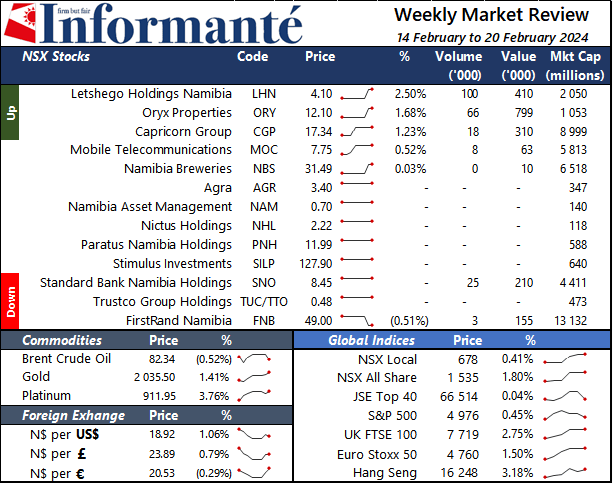This week in the local market, the Namibian Stock Exchange (NSX) indices showed a positive trend. The NSX Local index rose by 0.41% to reach 677.6, while the NSX Overall Index saw a more significant increase of 1.80%, closing at 1534.6. As of February 20, 2024, FirstRand Namibia emerged as the largest local company on the exchange, boasting a market capitalization of N$ 13.1 billion. It was closely followed by the Capricorn Group, which held a market capitalization of N$ 9.0 billion. Namibia Breweries and Mobile Telecommunications also made their mark with market capitalizations of N$ 6.5 billion and N$ 5.8 billion, respectively. In terms of individual stock performance, Letshego Holdings Namibia led the pack this week. The company’s shares closed at N$ 4.1 each, reflecting a growth of 2.5%. Not far behind was Oryx Properties, which saw its shares close at N$ 12.1, marking a growth of 1.7%. When it came to trading volume, Oryx Properties again took the lead, with shares worth N$ 0.8 million being traded. Letshego Holdings Namibia followed suit with N$ 0.4 million worth of shares traded. On the currency front, the local currency made gains against the US Dollar and the British Pound, appreciating by 1.06% and 0.79% respectively to close at N$ 18.92 per USD and N$ 23.89 per GBP. However, it lost ground against the Euro, depreciating by 0.29% to close at N$ 20.53.
The Bank of Namibia’s Monetary Policy Committee (MPC) opted for caution at its first meeting of 2024, keeping the key Repo rate unchanged at 7.75%. This decision reflects a delicate balancing act between supporting economic growth and maintaining the stability of the Namibia Dollar, which is pegged to the South African Rand. While domestic economic activity expanded in 2023, led by sectors like mining, tourism, and communication, the outlook for 2024 is tempered. Growth is projected to slow to 3.4%, partly due to continued weakness in construction. However, a key upside came in the form of moderating inflation. After easing to 5.9% in 2023, inflation dipped further to 5.4% in January and is expected to average 4.8% this year. This, coupled with positive real interest rates, provided some leeway for the MPC to hold rates steady. Another factor influencing the decision was the slight improvement in private sector credit extension, a key driver of economic activity. Though growth remains subdued at 1.9%, it represents a modest uptick from October 2023. The MPC anticipates a further, albeit gradual, rise to 2.8% in 2024. Looking beyond Namibia’s borders, the trade deficit narrowed in 2023 on the back of stronger export earnings, particularly from mining. This, combined with sufficient international reserves providing 3.7 months of import cover, bolstered the central bank’s confidence in maintaining the currency peg. Overall, the MPC’s decision to hold rates reflects a cautious optimism. While acknowledging the need to support economic growth, the central bank remains committed to safeguarding the Namibia Dollar’s stability. With inflation under control and reserves adequate, the MPC has bought itself some time to observe how the domestic and global economic landscapes evolve before considering any future adjustments.



Leave a Reply